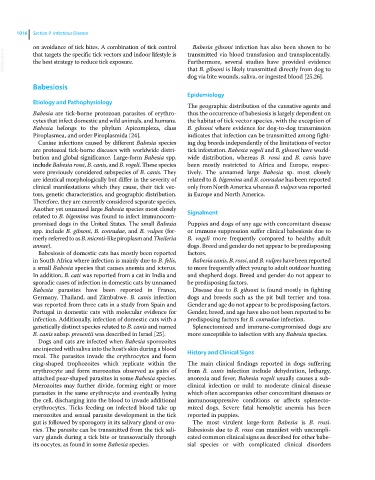Page 1078 - Clinical Small Animal Internal Medicine
P. 1078
1016 Section 9 Infectious Disease
on avoidance of tick bites. A combination of tick control Babesia gibsoni infection has also been shown to be
VetBooks.ir that targets the specific tick vectors and indoor lifestyle is transmitted via blood transfusion and transplacentally.
Furthermore, several studies have provided evidence
the best strategy to reduce tick exposure.
that B. gibsoni is likely transmitted directly from dog to
dog via bite wounds, saliva, or ingested blood [25,26].
Babesiosis
Epidemiology
Etiology and Pathophysiology
The geographic distribution of the causative agents and
Babesia are tick‐borne protozoan parasites of erythro- thus the occurrence of babesiosis is largely dependent on
cytes that infect domestic and wild animals, and humans. the habitat of tick vector species, with the exception of
Babesia belongs to the phylum Apicomplexa, class B. gibsoni where evidence for dog‐to‐dog transmission
Piroplasmea, and order Piroplasmida [24]. indicates that infection can be transmitted among fight-
Canine infections caused by different Babesia species ing dog breeds independently of the limitations of vector
are protozoal tick‐borne diseases with worldwide distri- tick infestation. Babesia vogeli and B. gibsoni have world-
bution and global significance. Large‐form Babesia spp. wide distribution, whereas B. rossi and B. canis have
include Babesia rossi, B. canis, and B. vogeli. These species been mostly restricted to Africa and Europe, respec-
were previously considered subspecies of B. canis. They tively. The unnamed large Babesia sp. most closely
are identical morphologically but differ in the severity of related to B. bigemina and B. conradae has been reported
clinical manifestations which they cause, their tick vec- only from North America whereas B. vulpes was reported
tors, genetic characteristics, and geographic distribution. in Europe and North America.
Therefore, they are currently considered separate species.
Another yet unnamed large Babesia species most closely Signalment
related to B. bigemina was found to infect immunocom-
promised dogs in the United States. The small Babesia Puppies and dogs of any age with concomitant disease
spp. include B. gibsoni, B. conradae, and B. vulpes (for- or immune suppression suffer clinical babesiosis due to
merly referred to as B. microti‐like piroplasm and Theileria B. vogeli more frequently compared to healthy adult
annae). dogs. Breed and gender do not appear to be predisposing
Babesiosis of domestic cats has mostly been reported factors.
in South Africa where infection is mainly due to B. felis, Babesia canis, B. rossi, and B. vulpes have been reported
a small Babesia species that causes anemia and icterus. to more frequently affect young to adult outdoor hunting
In addition, B. cati was reported from a cat in India and and shepherd dogs. Breed and gender do not appear to
sporadic cases of infection in domestic cats by unnamed be predisposing factors.
Babesia parasites have been reported in France, Disease due to B. gibsoni is found mostly in fighting
Germany, Thailand, and Zimbabwe. B. canis infection dogs and breeds such as the pit bull terrier and tosa.
was reported from three cats in a study from Spain and Gender and age do not appear to be predisposing factors.
Portugal in domestic cats with molecular evidence for Gender, breed, and age have also not been reported to be
infection. Additionally, infection of domestic cats with a predisposing factors for B. conradae infection.
genetically distinct species related to B. canis and named Splenectomized and immune‐compromised dogs are
B. canis subsp. presentii was described in Israel [25]. more susceptible to infection with any Babesia species.
Dogs and cats are infected when Babesia sporozoites
are injected with saliva into the host’s skin during a blood History and Clinical Signs
meal. The parasites invade the erythrocytes and form
ring‐shaped trophozoites which replicate within the The main clinical findings reported in dogs suffering
erythrocyte and form merozoites observed as pairs of from B. canis infection include dehydration, lethargy,
attached pear‐shaped parasites in some Babesia species. anorexia and fever, Babesia vogeli usually causes a sub-
Merozoites may further divide, forming eight or more clinical infection or mild to moderate clinical disease
parasites in the same erythrocyte and eventually lysing which often accompanies other concomitant diseases or
the cell, discharging into the blood to invade additional immunosuppressive conditions or affects splenecto-
erythrocytes. Ticks feeding on infected blood take up mized dogs. Severe fatal hemolytic anemia has been
merozoites and sexual parasite development in the tick reported in puppies.
gut is followed by sporogony in its salivary gland or ova- The most virulent large‐form Babesia is B. rossi.
ries. The parasite can be transmitted from the tick sali- Babesiosis due to B. rossi can manifest with uncompli-
vary glands during a tick bite or transovarially through cated common clinical signs as described for other babe-
its oocytes, as found in some Babesia species. sial species or with complicated clinical disorders

